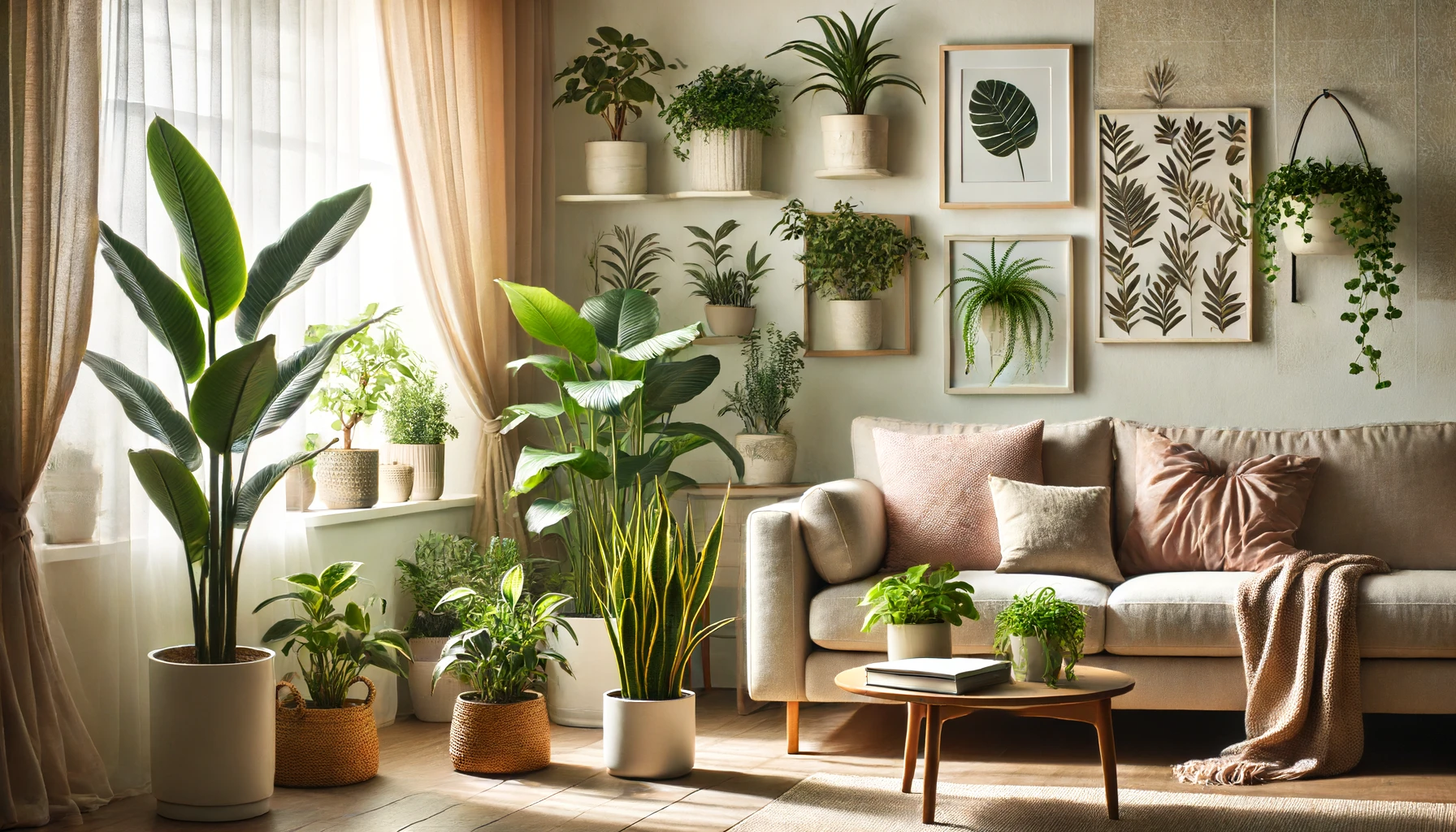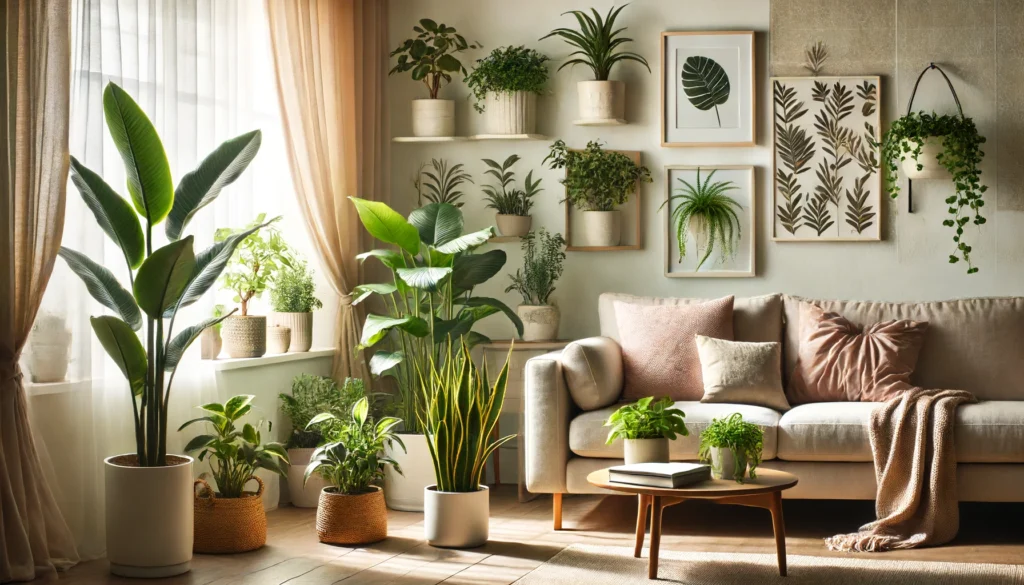Best Indoor Plants for Low Light Conditions

Indoor plants can transform your living space, bringing in a breath of fresh air and a touch of nature. However, not everyone is blessed with sun-drenched rooms, and finding plants that thrive in low light conditions can be a challenge. Fear not! This guide will introduce you to the best indoor plants for low light conditions that flourish even in the shadiest corners of your home.

Benefits of Indoor Plants
Air Purification
Indoor plants are nature’s air purifiers. They absorb toxins, release oxygen, and improve the overall air quality, making your home a healthier place to live. Common pollutants such as benzene, formaldehyde, and trichloroethylene are absorbed and broken down by the roots and leaves of plants.
Stress Reduction
Plants have a calming effect on people. Their presence can reduce stress, boost your mood, and even improve concentration and productivity. Studies have shown that interacting with indoor plants can lower blood pressure, reduce feelings of stress and anxiety, and enhance overall well-being.
Aesthetic Appeal
Adding plants to your home decor can instantly enhance its visual appeal. They bring color, life, and a sense of tranquility to any room. Whether you’re aiming for a minimalist look or a lush, jungle-like atmosphere, there’s a plant that will fit perfectly into your design scheme.
Humidity Regulation
Plants naturally increase humidity by releasing moisture through a process called transpiration. This can help mitigate dry indoor air, particularly during winter months when heating systems can lower humidity levels drastically.
Understanding Low Light Conditions
Definition of Low Light
Low light is typically defined as a space that is at least 10 feet away from a south-facing window or an area that receives indirect light throughout the day. These areas do not receive direct sunlight and may only get ambient light reflected from walls or other surfaces.
Identifying Low Light Areas in Your Home
Look for rooms with small windows, north-facing windows, or those shaded by trees and buildings. Bathrooms, hallways, and basements are common low light areas. Even rooms with larger windows can have low light spots if they are positioned away from direct sunlight.
Impact of Low Light on Plant Growth
Low light conditions can slow down the growth of plants, as they receive less energy from sunlight for photosynthesis. However, many plants have adapted to thrive in these environments by developing larger leaves to capture more light or by growing more slowly to conserve energy.
Top Indoor Plants for Low Light Conditions
Snake Plant (Sansevieria)
Description
The Snake Plant, also known as the Mother-in-Law’s Tongue, is a hardy plant with sword-like leaves that stand upright. It’s known for its ability to tolerate neglect and low light conditions.
Care Tips
- Water sparingly; allow the soil to dry out between waterings.
- Thrives in indirect light but can tolerate low light.
- Avoid overwatering to prevent root rot.
ZZ Plant (Zamioculcas zamiifolia)
Description
The ZZ Plant is known for its thick, waxy leaves that reflect sunlight, making it a glossy addition to any room. It’s virtually indestructible and can survive in almost any light condition.
Care Tips
- Water only when the soil is completely dry.
- Tolerates low light but prefers indirect light.
- Keep away from direct sunlight.
Pothos (Epipremnum aureum)
Description
Pothos, also known as Devil’s Ivy, has heart-shaped, variegated leaves that can grow quite long, making it perfect for hanging baskets or trailing down from shelves.
Care Tips
- Water when the top inch of soil feels dry.
- Can thrive in low light but prefers bright, indirect light.
- Prune regularly to control growth and encourage bushiness.
Peace Lily (Spathiphyllum)
Description
Peace Lilies are known for their white, hooded flowers and lush, dark green leaves. They are excellent air purifiers and can bloom even in low light conditions.
Care Tips
- Keep the soil moist but not soggy.
- Prefers low to bright indirect light.
- Mist the leaves to increase humidity.
Spider Plant (Chlorophytum comosum)
Description
Spider Plants have long, arching leaves and produce small “spiderettes” that hang down from the mother plant, making them perfect for hanging baskets.
Care Tips
- Water regularly but allow the soil to dry out between waterings.
- Thrives in low to moderate light.
- Fertilize monthly during the growing season.
Cast Iron Plant (Aspidistra elatior)
Description
The Cast Iron Plant is incredibly resilient, with broad, dark green leaves that can withstand neglect and low light. It’s a favorite for those with less than ideal conditions.
Care Tips
- Water moderately; avoid waterlogging.
- Tolerates low light very well.
- Ideal for areas with minimal natural light.
Chinese Evergreen (Aglaonema)
Description
Chinese Evergreens have striking, variegated leaves in shades of green, silver, and red, adding a pop of color to low light areas.
Care Tips
- Water when the top inch of soil is dry.
- Prefers low to medium light.
- Avoid cold drafts.
Dracaena
Description
Dracaenas come in various forms, often with tall, thin leaves that can be green or variegated with stripes. They’re adaptable and can handle low light environments.
Care Tips
- Water when the top layer of soil feels dry.
- Prefers low to medium indirect light.
- Prune to remove dead leaves and encourage new growth.
Philodendron
Description
Philodendrons are versatile plants with heart-shaped leaves, perfect for hanging baskets or as tabletop plants. They are easy to care for and can adapt to low light.
Care Tips
- Water when the top inch of soil is dry.
- Thrives in low to medium light.
- Regularly clean the leaves to remove dust.
Parlor Palm (Chamaedorea elegans)
Description
The Parlor Palm is a classic indoor plant with delicate, feathery fronds that add a touch of elegance to any room. It’s slow-growing and ideal for low light conditions.
Care Tips
- Water when the top inch of soil is dry.
- Prefers low to moderate light.
- Mist occasionally to maintain humidity.
Additional Indoor Plants for Low Light
English Ivy (Hedera helix)
Description
English Ivy is a versatile climber with lobed leaves that can add a touch of greenery to any low light area.
Care Tips
- Keep the soil evenly moist.
- Thrives in low to moderate light.
- Prune to control growth and prevent legginess.
Bromeliads
Description
Bromeliads are tropical plants with striking, colorful flowers and a rosette of leaves. They can adapt to low light environments and add a splash of color.
Care Tips
- Water the center of the plant rather than the soil.
- Prefers low to bright indirect light.
- Ensure good air circulation around the plant.
Ferns (Nephrolepis exaltata, Asplenium nidus)
Description
Ferns like the Boston Fern and Bird’s Nest Fern are known for their lush, feathery fronds. They thrive in low light and high humidity conditions.
Care Tips
- Keep the soil consistently moist.
- Prefers low to moderate indirect light.
- Increase humidity by misting regularly.
How to Care for Low Light Plants
Watering Needs
Low light plants typically require less water than their sun-loving counterparts. It’s essential to let the soil dry out between waterings to prevent root rot. Use your finger to check the soil moisture before watering.
Soil Requirements
Use well-draining soil to avoid waterlogged roots. A mix of potting soil with perlite or sand works well. Ensure that your pots have drainage holes to allow excess water to escape.
Fertilizing Tips
Feed low light plants with a balanced, water-soluble fertilizer every 4-6 weeks during the growing season. Reduce feeding in the winter months when plant growth naturally slows down.
Pruning and Maintenance
Regularly prune dead or yellowing leaves to encourage new growth and maintain the plant’s shape. Dust the leaves to keep them clean and promote efficient photosynthesis. Use a damp cloth to gently wipe the leaves.
Dealing with Dust and Dirt on Leaves
Dust and dirt can block light absorption and hinder photosynthesis. Clean your plants’ leaves regularly with a soft, damp cloth or by gently rinsing them under lukewarm water. This will help keep them healthy and looking their best.
Common Issues and Solutions
Yellowing Leaves
Yellow leaves can indicate overwatering, poor drainage, or nutrient deficiencies. Ensure the soil dries out between waterings and use a well-draining potting mix. Check for pests and consider using a balanced fertilizer to address nutrient deficiencies.
Root Rot
Root rot is caused by excessive moisture and poor drainage. To prevent it, avoid overwatering and ensure your pot has drainage holes. If you suspect root rot, remove the affected plant from its pot, trim away the rotted roots, and repot in fresh, well-draining soil.
Pests
Common pests include spider mites, mealybugs, and aphids. Treat infestations with insecticidal soap or neem oil, and keep the plants clean and healthy to prevent pests. Regularly inspect your plants for signs of pests and take action immediately if you notice any.
Creating an Ideal Environment for Low Light Plants
Use of Artificial Lighting
If natural light is insufficient, consider using artificial lighting to supplement your plants’ needs. LED grow lights are energy-efficient and can provide the necessary light spectrum for plant growth. Position the lights 6-12 inches above the plants and use a timer to mimic natural daylight hours.
Maintaining Humidity
Many low light plants thrive in high humidity environments. Increase humidity by placing a humidifier nearby, misting the plants regularly, or using a pebble tray with water. Grouping plants together can also help maintain a humid microclimate.
Proper Placement
Place low light plants in areas where they can receive ambient light, such as near windows with sheer curtains or in rooms with bright, indirect light. Rotate the plants periodically to ensure even growth and prevent them from leaning towards the light source.
Conclusion
Adding indoor plants to your home can bring numerous benefits, from cleaner air to reduced stress. Even in low light conditions, many beautiful and resilient plants can thrive. Embrace the greenery and enjoy the positive impact these plants can have on your living space. With the right care and attention, your indoor garden will flourish and bring joy for years to come.
FAQs
What qualifies as low light for plants?
Low light is typically an area that receives no direct sunlight and is often shaded or far from windows. Examples include bathrooms, hallways, and rooms with north-facing windows.
Can low light plants survive without sunlight?
While low light plants can survive in minimal light, they still need some indirect light to photosynthesize. Artificial light can also help supplement their needs.
How often should I water low light plants?
Watering needs vary, but generally, you should water low light plants when the top inch of soil feels dry. Overwatering can lead to root rot.
Do low light plants need fertilizer?
Yes, low light plants benefit from occasional feeding. Use a balanced, water-soluble fertilizer every 4-6 weeks during the growing season and reduce feeding in winter.
Are low light plants safe for pets?
Some low light plants, like the Spider Plant and Parlor Palm, are pet-friendly. However, others, like the ZZ Plant and Philodendron, can be toxic to pets. Always check plant toxicity if you have pets.

Leave a Comment